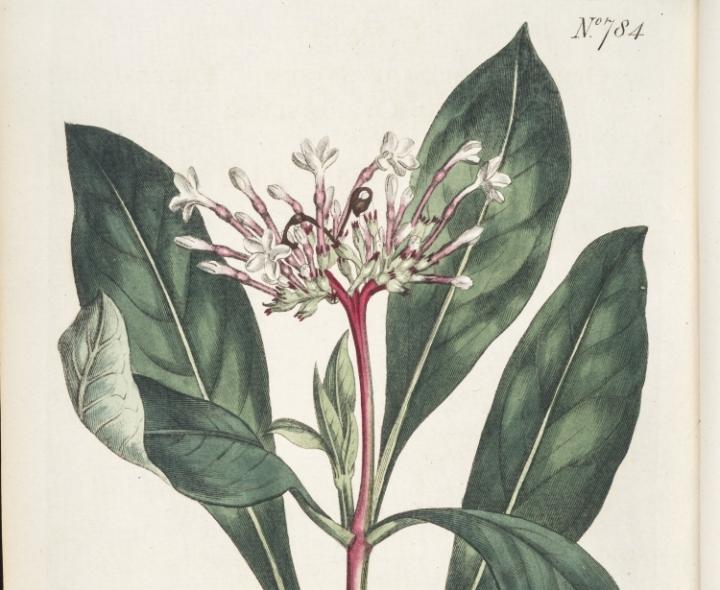
Credit: John Innes Centre
Chemical secrets of a plant used throughout history for its calming effects have been revealed in new research.
These new findings came from research into Indian Snakeroot (Rauwolfia serpentina) which has been used for millennia in South and South East-Asia as a tranquilizer.
The John Innes Centre team in the lab of Professor Sarah O'Connor followed clues from the recent past to identify the genetic networks behind a critical catalyst called a sarpagan bridge enzyme.
This generates an important chemical link to medicinally useful compounds in Indian snakeroot and many other plants.
Lead author of the paper Dr Thu Thuy Dang of the John Innes Centre said: "We set out to find the missing enzyme that catalyses this important reaction based on a 20-year-old clue from the literature.
"Thanks to the new advancements in bioinformatic and biological chemistry approaches, we were able to identify the missing gene that encodes the enzyme among thousands of other genes from the plant."
The discovery of the new oxidative enzyme that catalyzes intriguing chemistry could deliver faster routes to treatments for abnormal heart rhythms, high blood pressure and some mental disorders.
The study also found that the enzyme has an adaptable mechanism that could create a suite of structurally diverse chemical products.
Prof. Sarah O'Connor added: "The discovery of the sarpagan bridge enzyme, together with other scaffold generator enzymes, will provide the parts necessary for assembling and engineering of metabolic pathways in organisms such as yeast or tobacco plants for mass production of pharmaceutically important compounds. We are currently collaborating with experts in synthetic biology and yeast engineering to push this forward."
Indian snakeroot is one of the 50 fundamental herbs used in traditional Chinese medicine, where it has the name shég?n mù (Chinese: ???) or yìndù shémù (Chinese: ????).
It produces approximately 150 monoterpene indole alkaloids such as reserpine, yohimbine, and raubasine.
One of the best-known alkaloids in snakeroot is ajmaline, a class Ia antiarrhythmic agent often used in diagnosis of patients suspected of having Brugada syndrome, a condition that causes disruption to the heart's normal rhythm.
In other findings the study showed that the sarpagan bridge enzyme bridges two carbon atoms, a reaction particularly challenging for synthetic organic chemists, and so creates the complex three-dimensional structures found in the many class of alkaloids.
The study also demonstrated for the first time that the complex alkaloid vinorine can be produced in a different organism, requiring five enzymatic steps (including the newly discovered enzyme) from the readily available intermediate strictosidine.
Ultimately, this approach might be used to produce strictosidine-derived drugs such as ajmaline, which is used to treat abnormal heart rhythms, more efficiently.
Dr Jakob Franke said "The discovery highlights the versatility of this group of oxidative enzymes, which makes it a very useful biocatalyst and an excellent target for engineering these alkaloid pathways. We could use this enzyme to produce drugs in a much more elegant way than any synthetic chemist could."
The full paper can be found in Nature Chemical Biology.
Pictures/Media and captions: https://drive.google.com/open?id=1bCFSj0D8z3Y1IcYq0ZSy7Wj-HJzV0c7_
The DOI for this paper will be 10.1038/s41589-018-0078-4
###
Notes for Editors
Contacts
Press Contact: Adrian Galvin – [email protected]
Tel: 01603 450238 Out of Hours Tel: 07881 255193
About the John Innes Centre
The John Innes Centre is an independent, international centre of excellence in plant science and microbiology.
Our mission is to generate knowledge of plants and microbes through innovative research, to train scientists for the future, to apply our knowledge of nature's diversity to benefit agriculture, the environment, human health, and wellbeing, and engage with policy makers and the public.
To achieve these goals we establish pioneering long-term research objectives in plant and microbial science, with a focus on genetics. These objectives include promoting the translation of research through partnerships to develop improved crops and to make new products from microbes and plants for human health and other applications. We also create new approaches, technologies and resources that enable research advances and help industry to make new products. The knowledge, resources and trained researchers we generate help global societies address important challenges including providing sufficient and affordable food, making new products for human health and industrial applications, and developing sustainable bio-based manufacturing.
This provides a fertile environment for training the next generation of plant and microbial scientists, many of whom go on to careers in industry and academia, around the world.
The John Innes Centre is strategically funded by the Biotechnology and Biological Sciences Research Council (BBSRC). In 2015-2016 the John Innes Centre received a total of £30.1 million from the BBSRC.
The John Innes Centre is also supported by the John Innes Foundation through provision of research accommodation and long-term support of the Rotation PhD programme.
The John Innes Centre is the winner of the BBSRC's 2013 – 2016 Excellence with Impact award. For more information about the John Innes Centre visit our website http://www.jic.ac.uk
About BBSRC
The Biotechnology and Biological Sciences Research Council (BBSRC) is part of UK Research and Innovation, a non-departmental public body funded by a grant-in-aid from the UK government.
BBSRC invests in world-class bioscience research and training on behalf of the UK public. Our aim is to further scientific knowledge, to promote economic growth, wealth and job creation and to improve quality of life in the UK and beyond.
Funded by government, BBSRC invested £469 million in world-class bioscience in 2016-17. We support research and training in universities and strategically funded institutes. BBSRC research and the people we fund are helping society to meet major challenges, including food security, green energy and healthier, longer lives. Our investments underpin important UK economic sectors, such as farming, food, industrial biotechnology and pharmaceuticals
For more information about BBSRC, our science and our impact see: http://www.bbsrc.ac.uk
For more information about BBSRC strategically funded institutes see: http://www.bbsrc.ac.uk/institutes
Media Contact
Adrian Galvin
[email protected]
44-160-345-0238
@johninnescentre
http://www.jic.ac.uk
Related Journal Article
http://dx.doi.org/10.1038/s41589-018-0078-4




